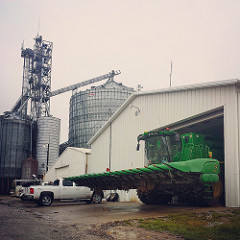Trends in Fixed Farm Expenses

While variable expenses – seed, fertilizer, crop protection, etc. – get a lot of attention, fixed expenses often account for a majority of the budget. In fact, we found 60% of budgeted corn and soybean production expenses are fixed (family labor, land, and machinery). After several years of adjustments in the farm sector, this week’s post is a review of trends in fixed farm expenses.
Fixed Farm Expenses
Each May, the Kansas Farm Management Association (KFMA) releases a summary of data collected and aggregated across nearly 1,000 farm operations. While these data are helpful in monitoring financial trends, keep in mind a diversity of operations and enterprises are included. This is to say we would expect variations of these trends across operations, enterprises, and geography.
Figure 1 shows the trend in two major categories of fixed expenses, depreciation, and family living. Broadly speaking, these have followed a similar trend of rapid increases before 2014, followed by moderation in recent years.
Family living expenses jump from $60,000 in 2010 to nearly $75,000 by 2014. After trending lower, this expense category returned to $73,000 in 2019.
Depreciation expense, which can take years to adjust given the long-life of assets, peaked in 2016 at nearly $66,000 but has since retreated to $63,000.

Figure 1. Farm Depreciation and Family Living Expenses, 2010-2019. Data Source: Kansas Farm Management Association.
While depreciation is a large share of machinery costs, figure 2 shows total machinery costs on an acre basis. After reaching nearly $100 per acre in 2014, machinery expense was $90 in 2019. Keep in mind this metric can adjust from a combination of 1) total machinery expense and 2) acres farmed.

Figure 2. Machinery cost per crop acre, 2010-2016. Data Sources: Kansas Farm Management Association.
The expense category that jumps out to us was farm interest expense. While we’ve reviewed interest expense at the national level, the KFMA data was pretty surprising when contrasted with the observed trends in family living, depreciation, and farm machinery. While other fixed costs moderated in recent years, farm interest expense jumped higher (figure 3). In 2019, the average farm interest expense was $32,000, up 64% since 2014. In other words, while additional fixed costs have slowed or moderated, interest expense has done nearly the opposite and rapidly accelerated since 2014.

Figure 3. Farm Interest Expense, 2010-2016. Data Sources: Kansas Farm Management Association.
Fixed Versus Variable (Corn)
Going back to variable versus fixed expense, the USDA reports national average costs and returns data for corn production. Figure 4 shows the average of the variable (in blue) and fixed (in red) costs of production. The question at hand is which costs adjusted the most?
Variable costs peaked in 2014 at $356 per acre. Over the last five years, this category has fallen by $23 per acre. On the other hand, fixed expenses over the same period (2014-2019) increased $22 per acre. The net impact – at least of this national-level data – is that total corn costs hit a low $669 per acre in 2017, but have trended higher in recent years ($689/acre in 2019).
One caveat: the 2019 cost estimates may change as the USDA finishes collecting and summarizing the relevant data. In recent years, it’s been common for the August net farm income estimates to adjust costs lower, especially fixed.

Figure 4. Operating Costs (variable) and Allocated Overhead Costs (fixed) of Production for Corn in the U.S.; 2010-2019. Data Source: USDA ERS.
Wrapping it Up
While the trend has been for producers to manage and control costs in light of low commodity prices, this doesn’t often play out in a uniform and linear process. The Kansas data shows that producers were able to adjust family living expense rather quickly, but this category has since drifted higher. Depreciation and machinery costs were a bit slower to adjust. On the other end of the spectrum, interest expense has increased considerably and likely undone any gains created by family living and depreciation improvements.
At the commodity level, the USDA’s national data shows that variable expenses have adjusted lower, but fixed expenses have continued to trend higher. Of course, we’d expect a lot of variability in this by geography.
At the farm level, producers should carefully consider their cost structure and monitor all components, not just variable expenses.